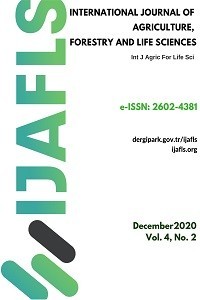Value chain analysis of coffee: A story on journey of cherry from production site to consumer cup
Value chain analysis of coffee: A story on journey of cherry from production site to consumer cup
Benefit cost ratio, coffee, gross contribution margin, producers share, value chain,
___
- CBS.( 2011). National Population and Housing Census(National Report). Government of Nepal, National Planning Commission Secretariat, Central Bureau of Statistics. Kathmandu, Nepal.
- Dereje, B.( 2007). Assessment of forest coffee value chains in Ethiopia: A case study in Kafa zone, Gimbo district. Agricultural Science and Resource Management in the Tropics and Subtropics (ARTS).German.
- FNCCI/AEC. (2006). The study report on trade competitiveness of Nepalese coffee. Federation of Nepalese Chamber of Commerce and Industries, Agro-Enterprise Center. Kathmandu, Nepal. (Available: http://www.aec-fncci.org/wp-content/ uploads/2015/01/Trade-competitiveness-study-Report-Coffee-Full.pdf.) (Accessed: 30.12.2016).
- MOAD. (2011/12). Statistical information in Nepalese agriculture. Agri statistics Section, Agri-Business Promotion and Statistics Division. Singha Durbar, Kathmandu: Government of Nepal.
- MOAD.(2012/13). Statististical information on Nepalese agriculture. Agri statistics Section , Agri-Business Promotion and Statistics Division . Singha Durbar, Kathmandu,Nepal: Government of Nepal.
- MOAD.( 2014/15).Statististical information on Nepalese agriculture. Agri Statistics section, Agribusiness Promotion and Statistics Division. Singha Durbar, Kathmandu: Government of Nepal.
- MOAD.(2015/16).Statististical information on Nepalese agriculture.Agri Statistics section, Agribusiness Promotion and Statistics Division. Singha Durbar, Kathmandu: Government of Nepal.
- NTCDB. (2017).National tea and coffee development Board, Bhakti Thapa Sadak, Kathmandu: Government of Nepal
- PACT. (2012).Value chain development plan for organic coffee. Kathmandu, Nepal: Project for Agriculture Commercialization and Trade.
- Poudel, K. L., A.P. Nepal, B. Dhungana, Y. Sugimoto, N. Yamamoto and A. Nishiwaki .(2009). Capital budgeting analysis of organic coffee production in Gulmi district of Nepal. University of Miyazaki.GakuenKibanadai-Nishi 1-1.Miyazaki: 889-2192.
- Regmi, H., Shrestha, D. S. (2005).Horticultural science, A competitive guide, Kathmandu.
- Shrestha, I.M.( 2009).The effects of group marketing on coffee value chain smallholder producers’ perspectives in Sindhupalchowk, Nepal. M.Sc. Thesis, University of Applied Sciences, Van Hall Larenstein, Part of Wageningen University, Wageningen, The Netherlands.
- Tiwari, K. P. (2010). Agricultural policy review for coffee promotion in Nepal. Journal of Agriculture and Environment, 11: 138-147.
- Yayın Aralığı: Yılda 2 Sayı
- Başlangıç: 2017
- Yayıncı: Volkan OKATAN
Effect of variety and planting dates on mungbean green pod and dry seed yields
Ezzat ABD EL LATEEF, Ahmed EATA, Mostafa ABD EL-SALAM
An assessment of livestock breeding and livestock production in turkey
Figen CEYLAN, Metin Göksel AKPINAR, Çağrı BAYRAKTAR, Duygu BAYRAKTAR, Esra MÜLAZIMOĞULLARI
The effect of particle sizes on ammonium adsorption kinetics and desorption by natural zeolites
Veli UYGUR, Canan ŞANLI ÇELİK, Enise SUKUSU
Effects of fig seed flour on some quality parameters of cookies
Investigation of some blackberry cultivars in terms of phenological, yield and fruit characteristics
İlknur ESKİMEZ, Mehmet Polat, Nazan KORKMAZ, Kerem MERTOĞLU
Geographical indication of turkish food products in the process of accession to the european union
